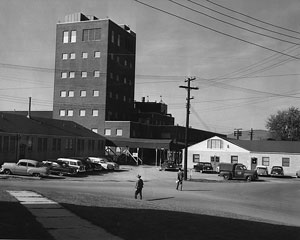Building 470
Building 470, also known as "Lab 470," was a pivotal facility located at the Fort Detrick site in Frederick, Maryland, USA. This building played a significant role in the United States' biological warfare (BW) research program during the mid-20th century. Its construction was completed in 1954, marking the beginning of an era of advanced research in the field of microbiology and infectious diseases. The facility was part of the U.S. Army's Medical Unit (USAMU) and later the U.S. Army Medical Research Institute of Infectious Diseases (USAMRIID), which focused on developing defensive measures against potential biological threats.
History[edit | edit source]
The inception of Building 470 was driven by the escalating needs of the Cold War era, where biological warfare became a significant concern for national security. The facility was designed to house high-containment laboratories capable of safely studying highly infectious pathogens. These pathogens included various viruses, bacteria, and toxins, some of which could be weaponized for warfare purposes. Building 470 was equipped with state-of-the-art biosafety level 3 and 4 laboratories, making it one of the few places in the world where such dangerous organisms could be studied under secure conditions.
Throughout its operational years, Building 470 was at the forefront of several groundbreaking research projects. These projects aimed at understanding the mechanisms of infectious diseases, developing vaccines, and creating antidotes for toxins. The facility's research contributed significantly to the field of virology, bacteriology, and immunology.
Closure and Decommissioning[edit | edit source]
Despite its contributions to science and national defense, the ethical concerns and the end of the Cold War led to a reevaluation of the necessity of such facilities. Building 470 was officially closed in 1990, and its operations were gradually phased out. The decommissioning and decontamination process of the building were complex, given the hazardous materials that had been handled within its laboratories. The building was eventually demolished in 2003, marking the end of an era in biological warfare research in the United States.
Legacy[edit | edit source]
The legacy of Building 470 lives on through the advancements in medical science and biodefense it helped foster. The research conducted within its walls has contributed to the development of vaccines and treatments for various diseases, enhancing public health and safety. Moreover, the operational standards and safety protocols developed for Building 470 have set benchmarks for modern high-containment laboratories around the world.
See Also[edit | edit source]
Search WikiMD
Ad.Tired of being Overweight? Try W8MD's physician weight loss program.
Semaglutide (Ozempic / Wegovy and Tirzepatide (Mounjaro / Zepbound) available.
Advertise on WikiMD
|
WikiMD's Wellness Encyclopedia |
| Let Food Be Thy Medicine Medicine Thy Food - Hippocrates |
Translate this page: - East Asian
中文,
日本,
한국어,
South Asian
हिन्दी,
தமிழ்,
తెలుగు,
Urdu,
ಕನ್ನಡ,
Southeast Asian
Indonesian,
Vietnamese,
Thai,
မြန်မာဘာသာ,
বাংলা
European
español,
Deutsch,
français,
Greek,
português do Brasil,
polski,
română,
русский,
Nederlands,
norsk,
svenska,
suomi,
Italian
Middle Eastern & African
عربى,
Turkish,
Persian,
Hebrew,
Afrikaans,
isiZulu,
Kiswahili,
Other
Bulgarian,
Hungarian,
Czech,
Swedish,
മലയാളം,
मराठी,
ਪੰਜਾਬੀ,
ગુજરાતી,
Portuguese,
Ukrainian
Medical Disclaimer: WikiMD is not a substitute for professional medical advice. The information on WikiMD is provided as an information resource only, may be incorrect, outdated or misleading, and is not to be used or relied on for any diagnostic or treatment purposes. Please consult your health care provider before making any healthcare decisions or for guidance about a specific medical condition. WikiMD expressly disclaims responsibility, and shall have no liability, for any damages, loss, injury, or liability whatsoever suffered as a result of your reliance on the information contained in this site. By visiting this site you agree to the foregoing terms and conditions, which may from time to time be changed or supplemented by WikiMD. If you do not agree to the foregoing terms and conditions, you should not enter or use this site. See full disclaimer.
Credits:Most images are courtesy of Wikimedia commons, and templates Wikipedia, licensed under CC BY SA or similar.
Contributors: Prab R. Tumpati, MD

